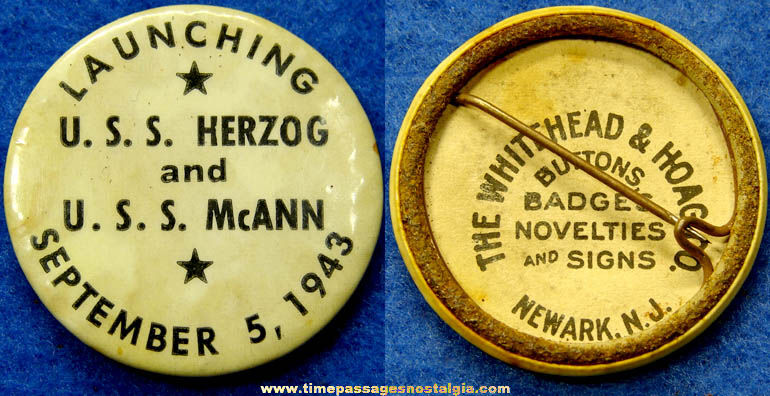
   | | Any group of items being offered as a lot must be sold as a lot. | | | | Unique & Fun Nostalgic Items | You can feel secure
shopping with PayPal. | | Worldwide Sales |  | Nostalgic Memorabilia, Pop Culture Artifacts, Historic Items,
and "Shoe Box Toys" | Quantity Discount Prices
(when available) | You don't have to be an eight year old to enjoy having
a childhood treasure. | | An Ever Changing Inventory |
| | | | The picture shows a front and back view of this 1943 U.S.S. Herzog & U.S.S. McAnn Ship Launching Pin Back Button. This launching badge is believed to have been saved by a shipyard worker. It was found in a Staten Island, New York attic with many others dating from 1941 to 1944 when many ships were launched to do battle in World War II. They had been hidden away in that attic from the 1940s until 2008. The ships were launched from The Federal Shipbuilding & Dry Dock of Kearny, New Jersey. This pinback button is imprinted in black on a white background. There is a paper insert in the back. It is marked on the two sides as follows: U.S.S. HERZOG
AND
U.S.S. McANN
LAUNCHING
SEPTEMBER 5, 1943 THE WHITEHEAD & HOAG CO.
NEWARK, N.J.
BUTTONS, BADGES, NOVELTIES AND SIGNS The pin back button measures 1-1/2'' wide. It is in fair condition with some spotting and surface rusting on the back as pictured. Below here, for reference, is some information on the U.S.S. Herzog and U.S.S. McAnn: U.S.S. Herzog (DE-178)
From Wikipedia, the free encyclopedia Career Laid down: 17 May 1943
Launched: 5 September 1943
Commissioned: 6 October 1943
Decommissioned: 1 August 1944
Struck: 20 July 1953
Fate: Transferred to Brazil, 1 August 1944 General characteristics Class: Cannon class destroyer escort
Type: DET (diesel electric tandem motor drive, long hull)
Displacement: 1,240 tons (std) 1,620 tons (full)
Length: 306 ft. (93 m) overall 300 ft. (91 m) waterline
Beam: 36 ft. 10 in. (11.2 m)
Draft: 11 ft. 8 in (3.6 m) maximum
Range: 10,800 nautical miles (20,000 km) at 12 knots (22 km/h)
Speed: 21 knots (39 km/h)
Complement: 15 officers, 201 enlisted
Armament: 3 - 3 inch (76 mm) / 50 caliber Mk 22, 1 twin 40 mm Mk 1 AA, 8 - 20 mm Mk 4 AA, 3 - 21 in. (530 mm) Mk 15 torpedo tubes, 1 Hedgehog Projector Mk 10 (144 rounds), 8 Mk 6 depth charge projectors, 2 Mk 9 depth charge tracks.
Propulsion: 4 GM Mod. 16-278A diesel engines with electric drive, 6,000 shp (4,500 kW), 2 screws. U.S.S. Herzog (DE-178) was a Cannon class destroyer escort built for the U.S. Navy during World War II. She served in the Atlantic Ocean and provided escort service against submarine and air attack for Navy vessels and convoys. Herzog was named in honor of William Ralph Herzog who was posthumously awarded the Navy and Marine Corps Medal for his heroism in trying to save his shipmates in 1942. The ship was launched by Federal Shipbuilding & Drydock Co., Kearny, New Jersey, 5 September 1943; sponsored by Mrs. Alice A. Herzog, mother of the namesake; and commissioned 6 October 1943, Lt. Comdr. J. C. Toft, Jr., in command. World War II Atlantic Ocean operations
After conducting shakedown operations out of Bermuda, Herzog steamed from New York 29 November 1943 on her first escort mission, accompanying the U.S.S. Ariel (AF-22) to the West Indies and back to New York. Arriving 18 December, she got underway as part of the escort for a merchant convoy. Protecting the ships through the dangerous Caribbean passages, Herzog arrived at the Panama Canal Zone 27 December. Subsequently she served as escort ship on shorter voyages between Recife, Brazil, and Trinidad. From 14 April 1944 until 14 July Herzog served with Task Group 41.6 on patrol in the South Atlantic. Working with the escort carrier U.S.S. Solomons (CVE-67) she searched the seas in the never ending battle against German submarines. On 15 June she was detached to pick up survivors from a German sub sunk by aircraft, and after returning to the group steamed to Recife, arriving 23 June. After another brief cruise with the Task Group, she returned to Recife 16 July. She sailed to the Brazilian Naval Base at Natal, Brazil, 28 July and was placed out of commission and loaned to the Brazilian Navy under lend lease 1 August 1944. The ship served Brazil as Beberibe (D-19), and on 30 June 1953 was transferred outright to that country under the Mutual Defense Assistance Program. The ship ran aground in February 1966, and was stricken and scrapped in 1968.
******************************************
U.S.S. McAnn (DE-179)
From Wikipedia, the free encyclopedia Career Laid down: 17 May 1943
Launched: 5 September 1943
Commissioned: 11 October 1943
Decommissioned: 15 August 1944
Struck: 20 July 1953
Fate: Transferred to Brazil, 15 August 1944 General characteristics Class: Cannon class destroyer escort
Type: DET (diesel electric tandem motor drive, long hull)
Displacement: 1,240 tons (std) 1,620 tons (full)
Dimensions: 306' (oa), 300' (wl) x 36' 10'' x 11' 8'' (max)
Range: 10,800 nm at 12 knots
Speed: 21 knots
Complement: 15 officers, 201 enlisted
Armament: 3 x 3''/50 Mk22 (1x3), 1 twin 40mm Mk1 AA, 8 x 20mm Mk 4 AA, 3 x 21'' Mk15 TT (3x1), 1 Hedgehog Projector Mk10 (144 rounds), 8 Mk6 depth charge projectors, 2 Mk9 depth charge tracks.
Propulsion: 4 GM Mod. 16-278A diesel engines with electric drive, 6000 shp, 2 screws. U.S.S. McAnn (DE-179) was a Cannon class destroyer escort built for the U.S. Navy during World War II. She served in the Atlantic Ocean and provided escort service against submarine and air attack for U.S. Navy vessels and convoys. McAnn was named after Donald Roy McAnn who received the Navy Cross for his actions during the Battle of Santa Cruz Islands in 1942. The ship was laid down by Federal Shipbuilding and Drydock Co., Kearny, New Jersey, 17 May 1943; launched 5 September 1943; sponsored by Mrs. Ethel Marie McAnn; and commissioned at New York 11 October 1943, Comdr. Charles F. Hooper in command. World War II Atlantic Ocean operations
After shakedown off Bermuda, McAnn operated along the east coast from Newport, Rhode Island, to Charleston, South Carolina, until 19 December 1943 when she departed Norfolk, Virginia, on a convoy escort run to the Panama Canal Zone. She reached Coco Solo 26 December, thence sailed the 31st for duty out of Key West, Florida. Arriving there 3 January 1944, she for the next several weeks with the Fleet Sound School and trained sailors in ASW techniques. Assigned to Escort Division 24, McAnn sailed for the Caribbean 29 February. Steaming via Trinidad, she joined convoy TJ 25 on 5 March and screened the ships through stormy seas en route to Recife, Brazil. On the 15th she rescued the entire crew of 10 men from a B-17 Flying Fortress which had splashed off the Brazilian coast the day before. McAnn arrived Recife 16 March. Between 2 and 12 April McAnn cruised to Trinidad in the screen of convoy JT 27, and during the next 3 months she completed three additional escort runs between the Caribbean and Brazil. She completed this duty 12 July and 4 days later departed Recife as screen for the U.S.S. Memphis. She cruised the South Atlantic in search of German submarines until returning to Recife 30 July. End of War decommissioning
McAnn underwent an upkeep and then steamed to Natal, Brazil, arriving 10 August. She decommissioned there 15 August and was transferred, under lend lease, to Brazil on the same date. She was commissioned in the Brazilian Navy on 16 August as Bauru. She served on loan with Brazilian Navy until 30 June 1953 when she was retransferred to Brazil, permanently, under the Mutual Defense Assistance Pact. |
|
Click on image to zoom.
 |